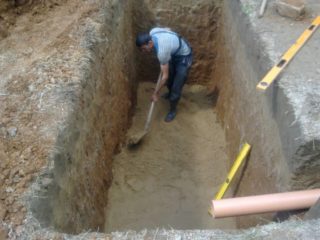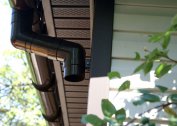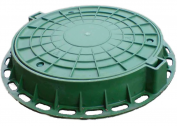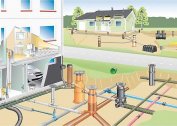A kitchen sink, a bathtub, a shower cabin, a toilet - all this fully provides comfort for living in a house outside the city, but at the same time requires the organization of reliable and effective treatment and disposal of waste water.
Pit or septic tank
 For a long time, the problems associated with the runoff of water were solved very simply - they dug a cesspool, in which everything accumulated. Such a pit needs to be cleaned from time to time, which is what communal service employees do. This is a very cheap option, but it is absolutely not suitable for modern cottages. Cleaning itself is always associated with not the most pleasant “aromas”, and this is very unaesthetic and creates discomfort for the residents of the house. So there is a need to arrange local wastewater treatment. A septic tank (a system similar to a sump) that can destroy more than 50% of contaminants is usually used. After it, the liquid enters the filter drainage.
For a long time, the problems associated with the runoff of water were solved very simply - they dug a cesspool, in which everything accumulated. Such a pit needs to be cleaned from time to time, which is what communal service employees do. This is a very cheap option, but it is absolutely not suitable for modern cottages. Cleaning itself is always associated with not the most pleasant “aromas”, and this is very unaesthetic and creates discomfort for the residents of the house. So there is a need to arrange local wastewater treatment. A septic tank (a system similar to a sump) that can destroy more than 50% of contaminants is usually used. After it, the liquid enters the filter drainage.
Septic tanks are very simple in construction, as well as non-volatile, in addition, for a family of 4 people, such a sump is quite enough. But at the same time, all sanitary standards must be observed: the sump should be at a distance of one meter and further from groundwater. You can also install a bio-treatment device.
And finally, you need to choose the materials from which the cleaning equipment is made. Septic tanks and bio-treatment plants, which were created using high-pressure polyethylene, fiberglass or polypropylene, are very resistant to biological and chemical influences. The treatment equipment is a ready-made module that does not need assembly. It is only necessary to strengthen it well in the ground. Unlike bio-treatment systems, septic tanks can be made from both polymers and reinforced concrete. Their cost is lower than plastic, but the installation process is much more complicated, requires more time. These containers serve up to thirty years. Optimum are those that were made of concrete B15 or high quality steel.
Installation Recommendations
 The place where the treatment system will be installed should be lower than the level of the house. In such a system, the stock will be made by itself, without the expense of electricity. If this is not done, there will be a need to install a sewage pump. In addition, during the planning of the territory, a number of other distances must be taken into account:
The place where the treatment system will be installed should be lower than the level of the house. In such a system, the stock will be made by itself, without the expense of electricity. If this is not done, there will be a need to install a sewage pump. In addition, during the planning of the territory, a number of other distances must be taken into account:
- not less than 5 meters from the house;
- 5 meters from the road;
- 3 meters from all vegetation;
- 10 meters from a river or stream;
- 30 meters from any other body of water.
To install the capacity you need to make a pit. At its bottom, a base is equipped, which consists of monolithic concrete blocks or a reinforced concrete slab. Top installation is covered with a small layer of soil. Outside, they leave a hatch, most often painted green. In septic tanks, it is used for cleaning after a certain period, and in biological treatment systems for technological maintenance.
You need to know that installing a septic tank and a treatment system is difficult for a beginner, so you should entrust this work to a professional. And it is worth purchasing equipment from the company that provides installation services and provides technological services. When making a purchase, you need to make sure that there is a sanitary certificate and permission from the sanitary and epidemiological station. If this is not the case, then installation is illegal.
Wiring
 Extensive and long experience in the operation of plastic elements during the installation of sewer systems in the European countries has: this material unconditionally defeated competitors with more familiar materials - steel and cast iron. Modern types of pipes for sewage are made from different materials: polypropylene, PVC, polyethylene. The most popular are made of PVC.They have a high level of resistance to chemical and biological substances, and are also lightweight, which simplifies installation. Ideally smooth inside the side is less subject to clogging.
Extensive and long experience in the operation of plastic elements during the installation of sewer systems in the European countries has: this material unconditionally defeated competitors with more familiar materials - steel and cast iron. Modern types of pipes for sewage are made from different materials: polypropylene, PVC, polyethylene. The most popular are made of PVC.They have a high level of resistance to chemical and biological substances, and are also lightweight, which simplifies installation. Ideally smooth inside the side is less subject to clogging.
Pipes are mounted, starting from the device farthest from the riser, simultaneously connecting the remaining spillway devices to it. The pipe must be located at a distance of at least 2 cm from any building structure. And from the hot water supply and heating systems, the pipe is diverted to a distance of at least 10 cm. As for sewer pipes, they should be lower than the hot pipeline. During the connection, it is necessary to make a slope of one or two centimeters for each linear meter of the pipeline.
Sewerage pipes have a large diameter, so they are difficult to hide, and this must be taken into account when planning all the systems at home. It is very good if all the bathrooms and bathrooms are located as close to the riser as possible to reduce the length of the pipes. In addition to the latter, you will need corners, all kinds of connecting parts and other similar elements. In this case, follow these recommendations: performing horizontal wiring in places where you need to rotate the pipeline 90 degrees, use 2 elbow connectors. If you want a right angle, this can only be done when the connections are vertical.


